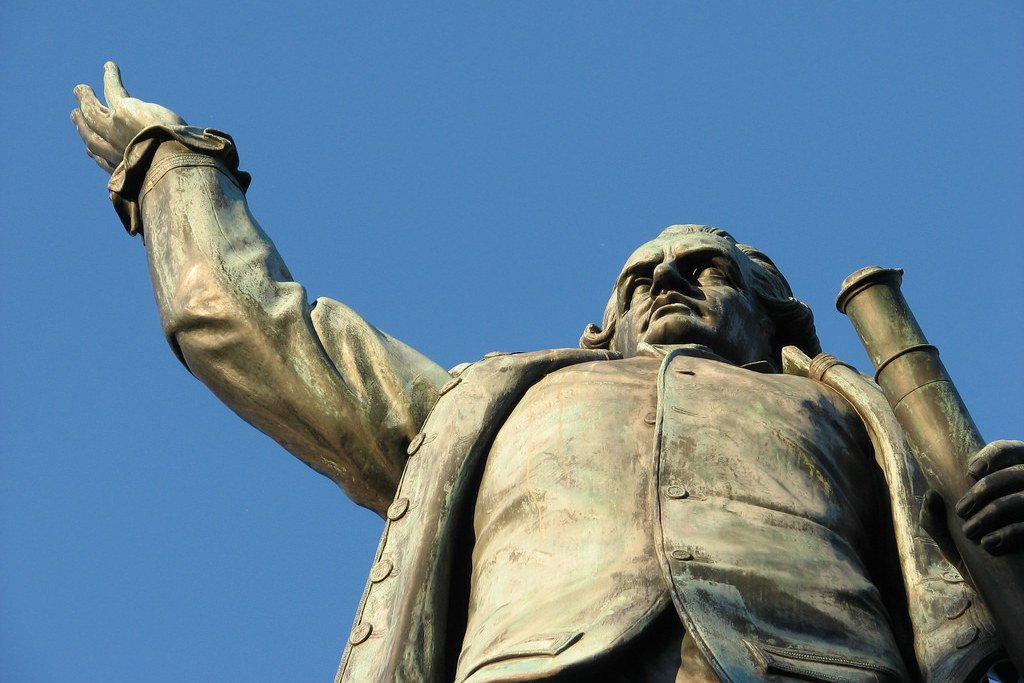Removing Colonial Statues Isn’t “Stalinism”, It’s Acknowledging Our Real History
We need to have this debate.

On Valentine’s Day in 1779 Captain James Cook was stabbed to death on Kealakekua Bay, after attempting to kidnap Kalaniʻōpuʻu, the chief of the island of Hawaii, and hold him for ransom.
Cook’s ill-fated journey to Hawaii came just one year after he became the first European to sail past the islands and nine years before the First Fleet landed on Australia’s east coast. It was Cook’s original 1770 voyage to Australia that precipitated the country’s eventual colonisation by the UK.
We learnt a lot about Captain Cook in school, particularly his role in “discovering” Australia, but I can’t recall ever hearing the story about his death. It could be because the preferred version of Australia’s colonisation taught to us clashed with the image of Cook being murdered by Hawaiians after exhibiting the kind of behaviour common amongst Europeans visiting the “New World”.
Nearly 240 years after Cook bled to death in the shallows of Kealakekua Bay, that sanitised version of Australia’s history is being interrogated. A political debate is raging over statues erected to honour his legacy, and that of other colonial figures including Governor Lachlan Macquarie. The debate — which mirrors campaigns in the US calling for Confederate statues to be pulled down — has drawn in Prime Minister Malcolm Turnbull, who referred to the tearing down of statues as something akin to “what Stalin did”.
But the call to re-evaluate the role played by Cook and Macquarie in the early days of colonisation isn’t about “re-writing history”, as conservatives allege. It’s about acknowledging the true history of this country and the foundation of dispossession it’s built on, and having the audacity to say it shouldn’t be venerated.
“America Tears Down Its Racist History, We Ignore Ours”
Indigenous journalist Stan Grant reignited debate over Australia’s colonial statues in an opinion piece earlier this month. Grant was specifically taking aim a statue of James Cook in Sydney’s Hyde Park which features a plaque claiming Cook “discovered this territory” in 1770.
“The statue speaks still to terra nullius [meaning ‘nobody’s land’] and the violent rupture of Aboriginal society and a legacy of pain and suffering that endures today,” Grant wrote. He went on to compare Australia’s willingness to accept these statues, and the way they are displayed, to the recent trend in the US of local and state governments pulling down Confederate monuments.
It’s a powerful juxtaposition. The rise of white supremacism and neo-Nazism in the US is forcing the country to challenge and confront its past. Statues venerating defenders of slavery like Robert E. Lee and Andrew Jackson are being removed as Americans understand they can remember their history without celebrating it.

The Daily Telegraph’s extremely sane response to Stan Grant.
Here in Australia we’re still in denial about our history. Grant calls it the “Great Australian Silence”. Politicians and the public refuse to accept the truth that Australia was built on violent dispossession and genocide, the legacy of which is still being experienced today. A genocide enacted by colonial rulers like Lachlan Macquarie, whose statues adorn the country and whose name marks countless rivers, bays, suburbs towns and even a university. All of us non-Indigenous Australians benefit from those acts of dispossession, some more than others. But we still largely deny they occurred and that their legacy lives on.
Unlike the broad cultural acceptance in the US that the country’s history of slavery was both real and abhorrent, Australians still refuse to accept settlement was anything but benign. It’s not just statues that highlight that, it’s signified through other cultural events as well like Australia Day.
Australia Day is held on the anniversary of the invasion of Australia by the First Fleet, yet despite repeated calls from Indigenous Australians to abandon a celebration of genocide, we persist. The federal government even deals out punishments to anyone who dares question our veneration of the day.
Like the colonial statues, the battle over Australia Day is a battle about history. But acknowledging our true history isn’t the same as burning it, whatever Malcolm Turnbull claims.
Statues Are Not History Books
Last weekend, after statues of Cook and Macquarie were covered in graffiti calling for the date of Australia Day to be changed, Turnbull wrote a lengthy Facebook post on the “totalitarian campaign” to “obliterate” history.
Turnbull was taking aim at those who called for the statues to be removed or, like Grant, wanted the plaques updated to reflect the reality of Cook’s contribution to Australia.
His post was a particularly strong example of intellectual bankruptcy. He compared calls to remove or re-contextualise statues to Stalin’s erasure of his political enemies from official records, which is particularly bizarre given the actual statues of Stalin have been torn down in the former Soviet Union. Is it Stalinism to remove statues of… Stalin?
He likened statues to history texts in a library and condemned the “new totalitarianism” that wanted to “burn” history. “Statues, inscriptions, monuments are all part of our history not simply because of what they record but of how it is recorded,” he said.
This line of argument is entirely spurious. Statues are nothing like history textbooks. They’re not attempts to tell a neutral perspective on events that occurred. We build them in support of a particular narrative that suits a specific ideological agenda.
When Confederate statues of racial segregation were built in the Jim Crow-era the goal was to perpetuate an ideology of white supremacy. When colonial statues were built to honour the likes of Cook and Macquarie it was about reinforcing the idea of Australia as an untamed, empty landscape settled by white visionaries who deserve to be lauded. Australia Day itself is a literal celebration of white invasion, reinforced every year on January 26.
The idea that statues are untouchable works of history is itself supremely ahistorical. Post-colonial history is full of examples of statues being demolished or repurposed. Numerous royal statues in Ireland were torn down as part of the republican movement’s campaign to eradicate the country’s colonial legacy. Has that somehow led to the “erasure” of history documenting Ireland’s brutal treatment at the hands of the British?
In India many royal statues were removed after independence. Has that erased India’s history as a British colony?
More recently the “Rhodes Must Fall” campaign successfully pushed for the removal of a statue venerating colonial advocate Cecil Rhodes in South Africa.
Plenty of countries have grappled with the legacy of colonisation, but here in Australia any attempt to even start a discussion about our history is met with the kind absurd rhetoric meted out by Turnbull.
The Debate We Have To Have
The pushback from conservatives on calls to change the date of Australia Day and re-assess our veneration of figures like Cook and Macquarie is predictable but it won’t work. It’s an attempt to project a specific vision of what Australia is and who it’s for. It’s much easier to persist with policies that continue to rob Indigenous people of their land and enact a racist immigration framework if your idea of Australia is a country built by white people for white people.
But the recent moves by local councils to reject Australia Day celebrations and the growing calls to reject the idolisation of colonial figures show the conservatives are losing the battle. There’s hope to be gained by looking at the US which, despite the election of Donald Trump, is removing Confederate statues at an accelerating rate.
Correcting the record and accepting the true history of Australia isn’t enough on its own to make up for hundreds of years of racially based violence and disposession. But it’s something the country can’t deny any longer.
—
Feature image via Peter Shanks/Flickr